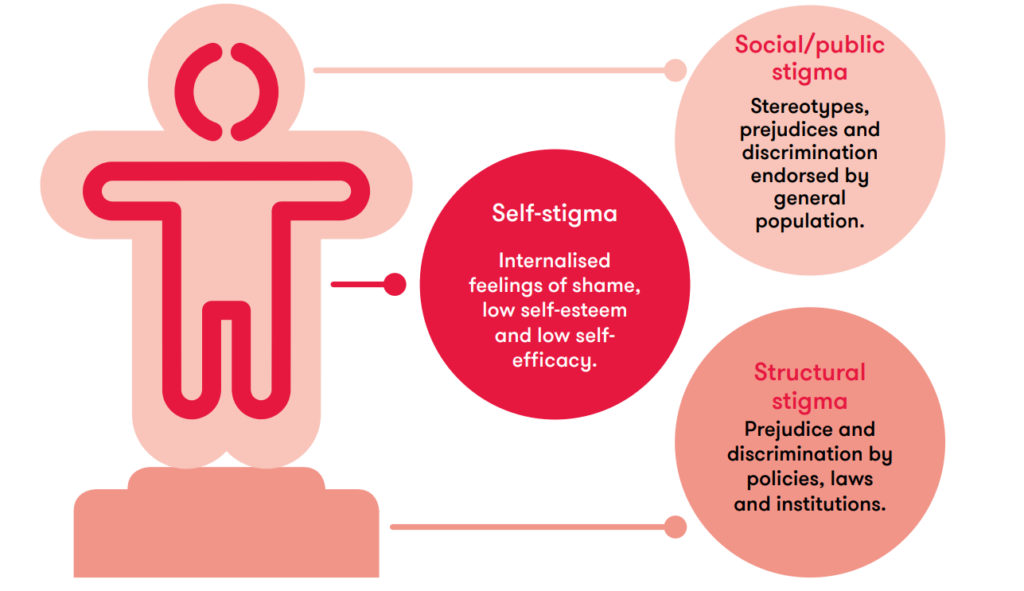ຢຸດຕິການໃສ່ຮ້າຍປ້າຍສີ ແລະເປັນຫຍັງມັນຈຶ່ງສຳຄັນ
Stigma ແມ່ນຫຍັງ?
ການດູຖູກແມ່ນທັດສະນະຄະຕິ ຫຼືພຶດຕິກຳທີ່ບໍ່ດີຕໍ່ບຸກຄົນ ຫຼືກຸ່ມຄົນຍ້ອນຄວາມເຊື່ອວ່າລັກສະນະ ຫຼືການປະພຶດນັ້ນເປັນຄວາມອັບອາຍ. ຮູບແບບການຈໍາແນກນີ້ຢືນຢັນໄດ້ວ່າ ເນື່ອງຈາກລັກສະນະ ຫຼືພຶດຕິກໍາທີ່ດູຖູກນີ້, ບຸກຄົນນັ້ນບໍ່ດີ, ອັນຕະລາຍ, ແລະ/ຫຼື ອ່ອນແອ.
ມີສາມປະເພດຕົ້ນຕໍຂອງການ stigma:
- ອັບອາຍຂາຍໜ້າຕົນເອງ
- ການປະນາມທາງສັງຄົມ/ສາທາລະນະ
- ແລະການຕົກຕະລຶງທາງໂຄງສ້າງ.
ຕົວເລກຂ້າງລຸ່ມນີ້ອະທິບາຍເຖິງການຕີກຽດເຫຼົ່ານີ້ ແລະວິທີທີ່ແຕກຕ່າງກັນທີ່ສະແດງເຖິງຄວາມກຽດຊັງ.

ເປັນຫຍັງການຕີກຽດຈຶ່ງມີຄວາມສຳຄັນ?
ມັນເປັນສິ່ງ ສຳ ຄັນທີ່ຈະຕ້ອງເຂົ້າໃຈຄວາມອັບອາຍເພາະວ່າການຕີຕາສ້າງສິ່ງກີດຂວາງຕໍ່ສຸຂະພາບແລະສະຫວັດດີການ - ຈາກການປ່ຽນແປງທັດສະນະຂອງບຸກຄົນທີ່ມີຕໍ່ຕົວເອງແລະການເລືອກສິ່ງທີ່ພວກເຂົາຮູ້ສຶກສະດວກສະບາຍ, ໄປສູ່ວິທີການປະຕິບັດໂດຍສັງຄົມແລະລະບົບ. ຜົນສະທ້ອນຂອງອຸປະສັກເຫຼົ່ານີ້ແມ່ນສໍາຄັນ. ການດູຖູກສາມາດສົ່ງຜົນກະທົບຄວາມໄວ້ວາງໃຈ, ສະຫນັບສະຫນູນຊຸມຊົນ, ສຸຂະພາບ, ແລະຊັບພະຍາກອນທີ່ສໍາຄັນອື່ນໆທີ່ຈະຟື້ນຟູ.
ການໃສ່ຮ້າຍປ້າຍສີການນໍາໃຊ້ສານເສບຕິດ, ໂດຍສະເພາະ, ສາມາດມີຜົນກະທົບທາງລົບຕໍ່:
- ການເຂົ້າເຖິງການປິ່ນປົວ
- ການຟື້ນຕົວແລະການສະຫນັບສະຫນູນ
- ສຸຂະພາບທາງກາຍ ແລະຈິດໃຈ
ຜົນກະທົບຂອງການໃສ່ຮ້າຍປ້າຍສີຕໍ່ການປິ່ນປົວ
ການຕັດສິນແລະຄວາມເຂົ້າໃຈຜິດກ່ຽວກັບການປິ່ນປົວສາມາດສົ່ງຜົນກະທົບຕໍ່ປະເພດຂອງການດູແລທີ່ຄົນເລືອກ, ຫຼືແມ້ກະທັ້ງພວກເຂົາຊອກຫາການປິ່ນປົວທັງຫມົດ. ມັນຍັງສາມາດນໍາພາຄົນໃຫ້ເຊື່ອງຄວາມບໍ່ເປັນລະບຽບຂອງການໃຊ້ສານເສບຕິດຂອງເຂົາເຈົ້າແລະຫຼີກເວັ້ນການຊອກຫາການສະຫນັບສະຫນູນ.
Stigma ຍັງສົ່ງຜົນກະທົບຕໍ່ຜູ້ທີ່ຢູ່ໃນການປິ່ນປົວ. ເຖິງແມ່ນວ່າຢາແມ່ນເປັນເຄື່ອງມືທີ່ມີປະສິດທິພາບສູງໃນການຟື້ນຟູ, ຍັງມີຄວາມບໍ່ພໍໃຈກ່ຽວກັບການປິ່ນປົວທີ່ມີການຊ່ວຍເຫຼືອທາງການແພດ (MAT) ແລະການໃຊ້ຢາເຊັ່ນ: methadone ແລະ buprenorphine. ຢາເຫຼົ່ານີ້ຫຼຸດຜ່ອນຄວາມຢາກກິນຢາ opioid, ຊ່ວຍອາການຖອນຕົວ, ແລະຊ່ວຍໃຫ້ຄົນຢູ່ໃນການປິ່ນປົວ.
ຜົນກະທົບຂອງການໃສ່ຮ້າຍປ້າຍສີກ່ຽວກັບຊັບພະຍາກອນອື່ນໆທີ່ຈະຟື້ນຕົວ
ການດູຖູກມີຜົນກະທົບຕໍ່ການເຂົ້າເຖິງການສະຫນັບສະຫນູນທີ່ສໍາຄັນອື່ນໆເຊັ່ນການສະຫນອງທຶນ, ສາຍພົວພັນສະຫນັບສະຫນູນ, ທີ່ຢູ່ອາໄສ, ແລະວຽກເຮັດງານທໍາ. ເຖິງວ່າສິ່ງເສບຕິດເປັນພະຍາດທີ່ປິ່ນປົວໄດ້ ແລະບໍ່ແມ່ນຄວາມຫຼົ້ມເຫຼວທາງສິນລະທຳ, ແຕ່ຜູ້ທີ່ມີຄວາມຜິດກະຕິໃນການໃຊ້ສານເສບຕິດມັກຈະຖືກປິ່ນປົວໂດຍບໍ່ມີຄວາມເຫັນອົກເຫັນໃຈ, ຄວາມເມດຕາ, ຫຼືການພິຈາລະນາພະຍາດທາງຮ່າງກາຍ. Stigma ສາມາດຈໍາກັດການເຂົ້າເຖິງການສະຫນັບສະຫນູນແລະແຍກຄົນອອກຈາກການຊ່ວຍເຫຼືອທີ່ພວກເຂົາຕ້ອງການໃນເສັ້ນທາງຂອງພວກເຂົາເພື່ອຟື້ນຕົວ.
ວິທີຫຼຸດຜ່ອນຄວາມອັບອາຍ
ການດູຖູກສາມາດໄດ້ຮັບການເສີມຂະຫຍາຍໂດຍຄວາມຄິດຜິດ, ຂາດຄວາມຮູ້, ແລະພາສາພິພາກສາ. ວິທີໜຶ່ງເພື່ອຫຼຸດຜ່ອນການຖືກດູຖູກແມ່ນໂດຍການກວດກາເບິ່ງທັດສະນະ, ຄວາມຄິດເຫັນ ແລະປະສົບການຂອງຕົນເອງກ່ຽວກັບຜູ້ທີ່ໃຊ້ຢາ. ໂດຍການຮັບຮູ້ຄວາມລໍາອຽງຂອງຕົນເອງຫຼາຍຂຶ້ນ, ທ່ານສາມາດກຽມພ້ອມທີ່ດີກວ່າທີ່ຈະຮັບຮູ້ແລະແກ້ໄຂຄວາມອັບອາຍໃນການສົນທະນາ, ໃນຄວາມສໍາພັນຂອງເຈົ້າ, ຫຼືໃນການເຮັດວຽກຂອງເຈົ້າ.
ແກ້ໄຂຄວາມເຂົ້າໃຈຜິດທົ່ວໄປແລະແບບຈໍາລອງ
ບໍ່ຖືກຕ້ອງ ສິ່ງເສບຕິດແມ່ນເກີດມາຈາກການຂາດຄວາມຕັ້ງໃຈແລະສິນທໍາ.
ຄວາມຈິງ: ຄວາມຜິດປົກກະຕິຂອງການນໍາໃຊ້ສານແມ່ນ ເປັນພະຍາດຊໍາເຮື້ອທີ່ສະລັບສັບຊ້ອນ ມັນສາມາດເປັນການຍາກແທ້ໆທີ່ຈະແກ້ໄຂໂດຍຜ່ານຄວາມຕັ້ງໃຈຢ່າງດຽວ. ມັນປ່ຽນແປງເຄມີຂອງສະຫມອງຂອງບຸກຄົນໃນທາງທີ່ເຮັດໃຫ້ເກີດຄວາມຢາກທີ່ເຂັ້ມແຂງແລະການເພິ່ງພາອາໄສ. ການເອື່ອຍອີງທາງກາຍະພາບຂອງຢາ opioid ນີ້ສາມາດຂັບໄລ່ຄົນໃຫ້ໃຊ້ຢາເສບຕິດແບບບັງຄັບ, ເຖິງວ່າຈະມີຜົນສະທ້ອນທີ່ເປັນອັນຕະລາຍແລະຄວາມສຸກຈາກສານຫຼຸດລົງ. ການເພິ່ງພາອາໄສທາງດ້ານຮ່າງກາຍນີ້ແມ່ນເຫດຜົນທີ່ວ່າ MAT ເປັນຊັບພະຍາກອນທີ່ມີປະສິດທິພາບໃນການຟື້ນຕົວ.
ບໍ່ຖືກຕ້ອງ Relapse ແມ່ນຄວາມລົ້ມເຫຼວ.
ຄວາມຈິງ: Relapse ເປັນອີກສ່ວນຫນຶ່ງຂອງການຟື້ນຕົວຈາກຄວາມບໍ່ເປັນລະບຽບຂອງການນໍາໃຊ້ສານເສບຕິດ. ມັນເປັນຂັ້ນຕອນທົ່ວໄປທີ່ຫຼາຍຄົນປະສົບຢູ່ໃນເສັ້ນທາງຂອງພວກເຂົາເພື່ອການຟື້ນຕົວ, ແລະການເກີດໃຫມ່ບໍ່ໄດ້ຫມາຍຄວາມວ່າບາງຄົນບໍ່ສາມາດຟື້ນຕົວໄດ້.
ບໍ່ຖືກຕ້ອງ Paraphernalia ເຊັ່ນ naloxone (Narcan) ແລະແຖບທົດສອບ fentanyl ສະຫນັບສະຫນູນການຕິດ.
ຄວາມຈິງ: ຍຸດທະສາດການຫຼຸດຜ່ອນຄວາມເສຍຫາຍແມ່ນເຄື່ອງມືທີ່ສໍາຄັນທີ່ຊ່ວຍສ້າງຄວາມໄວ້ວາງໃຈແລະສາມາດສະຫນັບສະຫນູນການຟື້ນຟູ. ຍຸດທະສາດເຫຼົ່ານີ້ແມ່ນວິທີການຮັບຮູ້ຄວາມສັບສົນຂອງຄວາມບໍ່ເປັນລະບຽບຂອງການໃຊ້ສານເສບຕິດແລະການສະຫນອງຜູ້ທີ່ໃຊ້ຢາເສບຕິດດ້ວຍເຄື່ອງມືເພື່ອຄວາມປອດໄພ.
ເພື່ອຮຽນຮູ້ເພີ່ມເຕີມກ່ຽວກັບການໃຊ້ຢາ ແລະສິ່ງເສບຕິດ, ເຂົ້າໄປເບິ່ງ: ຄວາມເຂົ້າໃຈກ່ຽວກັບການນໍາໃຊ້ຢາເສບຕິດ ແລະສິ່ງເສບຕິດຢາເສບຕິດ | ສະຖາບັນແຫ່ງຊາດກ່ຽວກັບການຕ້ານຢາເສບຕິດ (NIDA) (nih.gov)
ເຂົ້າໃຈພະລັງງານຂອງພາສາ
ພາສາແມ່ນມີອໍານາດ. ມັນສາມາດສ້າງທັດສະນະແລະຄວາມຄິດເຫັນກ່ຽວກັບການໃຊ້ສານເສບຕິດ. ແນວຄວາມຄິດແລະຄວາມຮູ້ສຶກທີ່ຄໍາສັບຕ່າງໆກະຕຸ້ນ, ພ້ອມກັບຄວາມຫມາຍຂອງຄໍາສັບຕ່າງໆ, ມີອໍານາດທີ່ຈະເສີມຫຼືຫຼຸດຜ່ອນຄວາມອັບອາຍ. ການໃຊ້ພາສາທີ່ເຫັນອົກເຫັນໃຈເປັນໂອກາດທີ່ຈະສະໜັບສະໜູນຜູ້ທີ່ປະສົບກັບຄວາມບໍ່ເປັນລະບຽບໃນການໃຊ້ສານເສບຕິດ ແລະເພື່ອຫຼຸດຜ່ອນຄວາມອັນຕະລາຍທີ່ເກີດຈາກພາສາຕັດສິນ.
ເມື່ອພວກເຮົາປ່ຽນພາສາຂອງພວກເຮົາໄປສູ່ຄໍາຄິດເຫັນທີ່ບໍ່ຫນ້າກຽດ, ພວກເຮົາສາມາດເລີ່ມຕົ້ນປ່ຽນແປງການສົນທະນາສາທາລະນະກ່ຽວກັບຄວາມບໍ່ເປັນລະບຽບຂອງການໃຊ້ສານເສບຕິດແລະຊ່ວຍຫຼຸດຜ່ອນອຸປະສັກຕໍ່ສຸຂະພາບແລະການຟື້ນຕົວ. ນີ້ສາມາດຮຽກຮ້ອງໃຫ້ມີການຝຶກຝົນຕົວເຮົາເອງເພື່ອໃຊ້ພາສາທີ່ແຕກຕ່າງກັນກວ່າທີ່ພວກເຮົາເຄີຍໃຊ້ໃນອະດີດ, ຫຼືພາສາທີ່ແຕກຕ່າງກັນກວ່າທີ່ພວກເຮົາໄດ້ຍິນຈາກຄົນອ້ອມຂ້າງພວກເຮົາ, ແຕ່ມັນກໍ່ສາມາດສ້າງຄວາມແຕກຕ່າງຢ່າງຫຼວງຫຼາຍຕໍ່ຄົນໃນຊຸມຊົນຂອງພວກເຮົາທີ່ຕໍ່ສູ້ກັບຄວາມບໍ່ເປັນລະບຽບຂອງການໃຊ້ສານເສບຕິດຫຼືຜູ້ທີ່. ມີຄົນທີ່ຮັກຕໍ່ສູ້ກັບມັນ.
ກຣາບຟິກຕໍ່ໄປນີ້ເນັ້ນໃສ່ວິທີການໃຊ້ພາສາລວມ.
ເອກະສານອ້າງອີງ
- Wogen, J., & Restrepo, MT (2020, ເດືອນມິຖຸນາ). ສິດທິມະນຸດ, ການໃສ່ຮ້າຍປ້າຍສີ, ແລະການໃຊ້ສານເສບຕິດ. ວາລະສານສຸຂະພາບ ແລະສິດທິມະນຸດ. ດຶງມາໃນວັນທີ 21 ກັນຍາ 2021, ຈາກ https://www.hhrjournal.org/2020/06/human-rights-stigma-and-substance-use/.
- ການປິ່ນປົວດ້ວຍຢາຊ່ວຍປິ່ນປົວ (MAT). ສມຊ. (2021, 16 ກັນຍາ). ດຶງມາໃນວັນທີ 21 ກັນຍາ 2021, ຈາກ https://www.samhsa.gov/medication-assisted-treatment.

